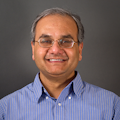Amit Acharya, Ph.D.
Professor, Carnegie Mellon University
From topological defects in elasticity to geometric field theories
Amit Acharya is a professor in the Department of Civil and Environmental Engineering at Carnegie Mellon University, and is a member of the Mechanics, Materials, and Computing (MMC) research group. He plans to use the Simons Pivot Fellowship to develop — in joint work with Ambar Sengupta — the mathematical background to establish a branch of mathematical gauge theory that is directly adapted to studying the dynamics and collective behavior of topological defects called dislocations and disclinations in nonlinear elastic solids. The ultimate goal is to be able to study topological defect dynamics in elasticity by Path Integral methods (at least in the finite dimensional approximation) to understand its statistical properties, and thus, hopefully, shed light on the plasticity of crystalline solids — a scientifically intricate, macroscopic phenomenon of great technological importance. Such a theory does not exist today; concepts from gauge theory have been employed to understand the statics of dislocation and disclination defects within a linearized ansatz of the geometry and kinematics of elastic deformations (the ‘small deformation’ assumption). Acharya’s interest is in the dynamics of such defects within the full theory of nonlinear elasticity. Interesting advances in dynamics, still restricted to the ‘small deformation’ setting, have been made in recent years, establishing analogies with the treatment of quantum gravity. The subject, whether statics or dynamics, is also gaining the attention of quantum field theorists.
Acharya is an engineer by training with expertise in continuum mechanics, theoretical materials science and applied mathematics. He looks forward to this opportunity, enabled by the Simons Foundation Pivot Fellowship, to interact with and learn from a mathematical physicist and, more generally, the broader community of experts in physics and mathematics engaged in the study and application of gauge theories.